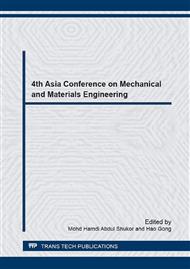p.41
p.45
p.50
p.54
p.59
p.63
p.69
p.73
p.77
Effect of Artificial Aging on Fracture Behavior of Al6061-Silica (SiO2) Composites
Abstract:
In the present work improvement in mechanical properties due to the presence of silicon oxide (SiO2) reinforced particles with an average size of 50μm and various weight percentage of (3, 6 and 9) on the hardness and fracture behaviour of Al6061-SiO2 composite is investigated. The influence of artificial aging with different aging temperatures on the mechanical properties was also assessed. Macro hardness and mechanism of fracture behaviour during tensile test have been discussed. Failure mode of fracture surface is studied to determine the parameters which influence the crack growth characteristics. Addition of SiO2 particles and artificially aging at 100°C for Al6061-SiO2 composite shows improvement in hardness by 140% and tensile strength by 60% due to the precipitation of finer secondary intermetallic phases of alloying elements. Fracture surface analysis for composite shows particle interface fracture and void nucleation growth failure.
Info:
Periodical:
Pages:
59-62
Citation:
Online since:
November 2016
Keywords:
Price:
Сopyright:
© 2017 Trans Tech Publications Ltd. All Rights Reserved
Share:
Citation:


